Treatment
PRP (Platelet-Rich Plasma)
PRP (Platelet-Rich Plasma) is a natural regenerative treatment that uses a small sample of your own blood to support skin renewal and stimulate healthier hair growth. Rich in growth factors, PRP is injected or micro-needled into the skin or scalp to encourage collagen production, improve texture, reduce signs of ageing, or help address hair thinning.
Because PRP harnesses your body’s own healing properties, it’s generally well tolerated with minimal downtime. Whether you’re looking to revitalise tired, dull skin or restore volume and strength to thinning hair, PRP offers a non-surgical, clinically backed solution tailored to your individual needs.

PRP (Platelet-Rich Plasma) therapy is a natural treatment that uses a small sample of your own blood to support collagen production, tissue repair, and skin or hair rejuvenation. It involves extracting the platelet-rich portion of your plasma—known for its high concentration of growth factors—and reintroducing it into targeted areas of the skin or scalp.
This treatment is commonly used to help improve the appearance of fine lines, texture, and elasticity in the skin, or to support fuller, healthier-looking hair. Because PRP uses your body’s own healing components, it is generally well tolerated and requires minimal downtime.
At The London Skin Clinic, PRP is administered by experienced clinicians in a sterile, clinical setting using high-grade medical centrifuges and protocols for safety and optimal results.
PRP Benefits for Skin
Suitable for the face, neck, chest, and hands
May improve overall skin tone and texture
Supports natural collagen and elastin production
May reduce the appearance of fine lines and early wrinkles
Can help restore a more radiant, refreshed complexion
May assist in minimising acne scars or skin irregularities
Enhances skin hydration and plumpness over time
PRP Benefits for Hair
May support hair regrowth in areas of thinning
Helps strengthen existing hair follicles
Can improve hair density and quality over time
May reduce hair shedding in some individuals
Suitable for early-stage hair loss or post-partum thinning
Uses your own blood, making it a natural and well-tolerated option
Please note: The information provided does not constitute medical advice and should not be relied upon as such. A full consultation is required to determine your suitability for this treatment, in accordance with TGA and AHPRA guidelines.
How does it work ?
PRP works by isolating platelets—tiny components in your blood that are rich in growth factors—through a careful process of blood collection and centrifugation. These platelets are then injected or micro-needled into areas of concern such as the face, neck, décolletage, or scalp. The growth factors in PRP stimulate the body’s natural processes to regenerate collagen, improve circulation, and encourage healthier cell turnover.
For skin, PRP can help improve overall tone, reduce the appearance of fine lines, and enhance skin texture over time. When used on the scalp, PRP is designed to stimulate dormant hair follicles and may support thicker, stronger hair growth in areas of thinning.
Because PRP relies on the body’s own biological processes, results develop gradually over several weeks and often continue to improve with a series of treatments. Your clinician will work with you to develop a personalised plan based on your skin or hair goals.
Suitable Candidates for PRP
PRP may be suitable for individuals who are noticing early signs of skin ageing, volume loss, dullness, or hair thinning. Ideal candidates are in good general health, are not pregnant or breastfeeding, and have no active infections or inflammatory conditions in the treatment area.
As with all treatments offered at The London Skin Clinic, your suitability for PRP will be determined during a comprehensive consultation. We’ll take the time to understand your goals, assess your skin or scalp condition, and tailor a treatment plan that aligns with your needs and expectations.
The PRP Procedure
The procedure begins with a small blood draw—similar to a standard pathology test. The sample is then placed in a centrifuge to separate the platelet-rich plasma from other blood components. Once prepared, the PRP is injected or applied using a micro-needling device depending on the treatment area and desired results.
For skin, PRP can be applied to the face, neck, chest, or hands. For hair, it is typically injected into areas of thinning at the crown or hairline. The process takes approximately 45–60 minutes, including preparation and aftercare. Most clients find the treatment well-tolerated, and topical numbing is available for added comfort.
A course of 3–4 treatments spaced 4–6 weeks apart is typically recommended, followed by maintenance treatments every 6–12 months if desired.
What is PRP and how does it work ?
PRP (Platelet-Rich Plasma) is a treatment that uses a concentrated portion of your own blood, rich in platelets and growth factors, to support natural tissue repair and regeneration. When injected or micro-needled into the skin or scalp, PRP stimulates collagen production and encourages healthier cellular activity, helping to improve skin quality or support hair growth.
Is PRP Safe ?
Yes. Because PRP is made from your own blood, it’s considered a natural treatment with minimal risk of allergic reaction or rejection. The procedure is performed in a sterile, clinical environment using medical-grade equipment to ensure safety and comfort.
What areas can be treated with PRP ?
For skin, PRP can be applied to the face, neck, décolletage, and hands to address signs of ageing and improve overall skin quality. For hair, PRP is commonly injected into the scalp in areas of thinning, particularly at the hairline or crown.
How many treatments will I need ?
Most clients benefit from a course of 3–4 treatments spaced 4–6 weeks apart, followed by maintenance treatments every 6–12 months depending on your goals. Your clinician will create a personalised plan during your consultation.
Is there downtime after PRP ?
There is minimal downtime. You may experience mild redness, swelling, or tenderness in the treated area for 24–72 hours. Some clients may experience light bruising, especially with scalp treatments, but this typically resolves quickly.
When will I see results ?
Results appear gradually as your skin or scalp responds to the growth factors in the PRP. For skin, clients often notice a more radiant and hydrated appearance within a few weeks. Hair improvements can take 3–6 months, depending on the individual.
Does the procedure hurt ?
Most clients find the treatment very tolerable. A topical numbing cream can be applied for skin treatments, and a fine needle is used for scalp injections. Discomfort is usually minimal and short-lived.
Can PRP treat all types of hair loss ?
PRP is most effective for individuals with early-stage hair thinning or post-partum hair loss. It may not be suitable for clients with advanced hair loss or underlying medical conditions affecting the scalp. Your suitability will be assessed during your consultation.
Who is not suitable for PRP treatment ?
PRP is not recommended for individuals who are pregnant or breastfeeding, or those with certain blood disorders, active skin infections, or inflammatory scalp conditions. A full medical history will be taken to ensure the treatment is safe and appropriate for you.
How should I prepare for my PRP session ?
Please see pricing and booking options here or contact us for further information.
Gallery




